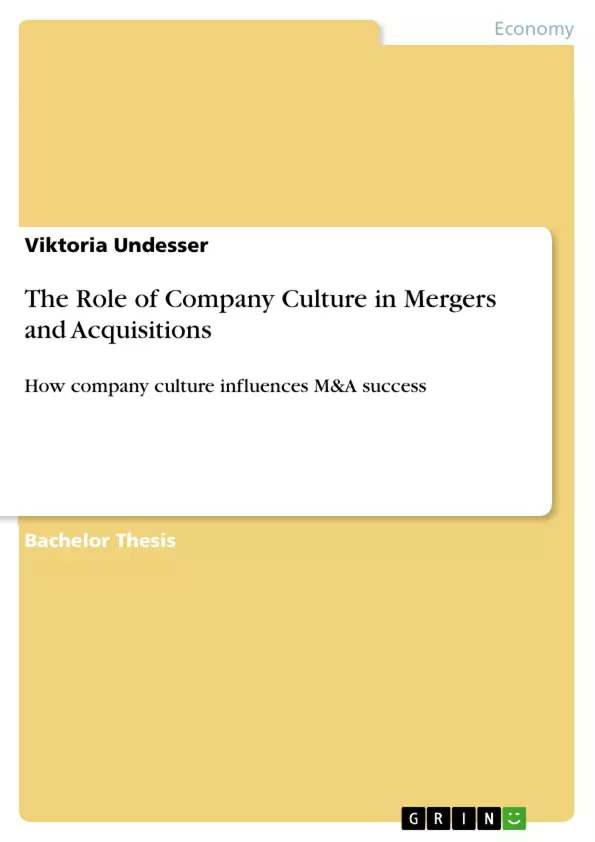This thesis will provide a clear understanding of how and why company culture is such an important factor in M&A. First of all, mergers, acquisitions and company culture will be defined. Then, different types of company cultures are analysed regarding their mutual compatibility. This is followed by an explanation of how cultural integration can take place and how managers can facilitate it. Finally, important findings are summarized and discussed.
As globalization progresses, so does the internationalization of companies. In the course of this development, over the last 30 years, the forming of mergers and acquisitions has become very popular. One of the greatest challenges in a merger or an acquisition is aligning the company culture of the merging partners before, during and after the merger. Company culture – or the lack of an integrated company culture - can crucially influence the success or failure of a merger or acquisition. However, in spite of the fact that there are a lot of ways to facilitate cultural integration, it is something that is often neglected in the planning phase, which makes it all the more difficult to accomplish successfully further along in the process.
Inhaltsverzeichnis (Table of Contents)
- Introduction
- Mergers and Acquisitions
- Definition and Implications of Mergers and Acquisitions
- Phases in a Merger or Acquisition
- Types of Mergers and Acquistions
- Motives and Objectives for Mergers and Acquisitions
- "Company Culture"
- What is an organizational or company culture?
- How can you change "Company Culture"?
- Communication
- Leadership
- Balancing processes
- Emotions
- How to measure and assess organizational culture
- Types of Organizational Cultures
- Power Orientation
- Patriarchal Power Culture
- Autocratic Culture
- Role Orientation
- Task Orientation
- Person Orientation
- In how far are employees' and company interests taken care of in the different types?
- The Relation between Culture Types as regards Constraints on Individuals' Freedom
- Power Orientation
- Cultural Fit
- Implications of cultural types for compatibility and cultural fit
- Strategies for cultural integration in Mergers and Modes of Acculturation
- Definition "Acculturation"
- Extension Mergers
- Collaborative Mergers
- Redesign Mergers
- Assimilation
- Deculturation
- Determination of Acculturation Strategy
- Conclusions drawn from Nahavandi and Malekzadeh's model
- Facilitators of cultural and company integration - Five drivers of Success
- Coherent Integration Strategy
- Strong Integration Team
- Communication
- Speed in Implementation
- Aligned Measurements
- Other Facilitators of Cultural Integration
- Discussion and Conclusion
- Sources
Zielsetzung und Themenschwerpunkte (Objectives and Key Themes)
This thesis aims to provide a comprehensive understanding of the critical role of company culture in mergers and acquisitions (M&As). It examines how cultural integration can be facilitated and what challenges arise in this process. The key themes explored in the text are:- The definition and implications of mergers and acquisitions
- The nature and impact of company culture on M&A success
- The various types of organizational cultures and their compatibility
- The strategies for cultural integration in mergers, including modes of acculturation
- The factors influencing the success of cultural integration in M&As
Zusammenfassung der Kapitel (Chapter Summaries)
The introduction sets the stage by discussing the importance of M&As in the global business landscape, highlighting the alarmingly high failure rate of these transactions. The chapter also emphasizes the crucial role of integrating company cultures in achieving M&A success. Chapter 2 delves into the definition and implications of mergers and acquisitions, outlining the different phases involved in the M&A process. Chapter 3 provides a detailed exploration of "company culture," defining its components and examining how it can be changed through various means, including communication, leadership, and balancing processes. Chapter 4 presents different types of organizational cultures, including power, role, task, and person orientations. Chapter 5 analyzes the compatibility and cultural fit between various types of organizational cultures, exploring their implications for successful integration in M&As. Chapter 6 explores strategies for cultural integration in mergers, including modes of acculturation, such as assimilation, deculturation, and other approaches. Chapter 7 examines the five key drivers of successful cultural integration in M&As: a coherent integration strategy, a strong integration team, effective communication, speed in implementation, and aligned measurements.Schlüsselwörter (Keywords)
This thesis focuses on the key concepts of mergers and acquisitions, company culture, cultural integration, acculturation strategies, and the factors influencing the success of cultural integration in M&As. The work delves into the different types of organizational cultures, their compatibility, and their implications for achieving successful integration in M&A transactions.- Quote paper
- Viktoria Undesser (Author), 2016, The Role of Company Culture in Mergers and Acquisitions, Munich, GRIN Verlag, https://www.grin.com/document/317880



